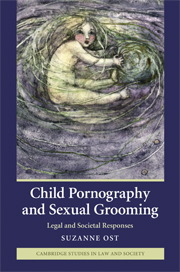Book contents
- Frontmatter
- Contents
- Acknowledgements
- Table of cases
- Dedication
- Introduction: Constructions, themes and critical tensions
- 1 The modern day phenomena of child pornography and sexual grooming
- 2 Criminalizing child pornography and behaviour related to sexual grooming
- 3 Matters of harm and exploitation
- 4 Moral panics and the impact of the construction of childhood innocence
- 5 The law elsewhere and questions of individual rights
- 6 Conclusions and implications
- Appendix A Details of dates of interviews with police officers
- Bibliography
- Index
5 - The law elsewhere and questions of individual rights
Published online by Cambridge University Press: 04 May 2010
- Frontmatter
- Contents
- Acknowledgements
- Table of cases
- Dedication
- Introduction: Constructions, themes and critical tensions
- 1 The modern day phenomena of child pornography and sexual grooming
- 2 Criminalizing child pornography and behaviour related to sexual grooming
- 3 Matters of harm and exploitation
- 4 Moral panics and the impact of the construction of childhood innocence
- 5 The law elsewhere and questions of individual rights
- 6 Conclusions and implications
- Appendix A Details of dates of interviews with police officers
- Bibliography
- Index
Summary
Many jurisdictions other than the UK have had to grapple with the problems of child pornography and sexual grooming. The initial discussion here is focused on the way in which Canadian and American jurisdictions have dealt with the phenomena. I have chosen to direct my comparative analysis on these jurisdictions for specific reasons. First, in both the United States and Canada, the criminalization of child pornography in particular has been examined through the critical lens of individual rights and freedoms to a greater degree than in this jurisdiction. This is no doubt due to the substantial, long-standing protection offered by the US constitution, and the longer history behind the Canadian Charter of Rights and Freedoms when compared to the Human Rights Act 1998. There is a history of robust judicial protection of free speech in both jurisdictions. Because of the powerful presence of the First Amendment, it is perhaps unsurprising that critical academic commentary and analysis on child pornography laws has been more prolific in the United States than in this jurisdiction. However, it is interesting that, despite the limits placed upon state power by the First Amendment and the Canadian Charter of Rights and Freedoms, the laws in both the United States and Canada still criminalize more material than English law.
- Type
- Chapter
- Information
- Child Pornography and Sexual GroomingLegal and Societal Responses, pp. 192 - 233Publisher: Cambridge University PressPrint publication year: 2009

